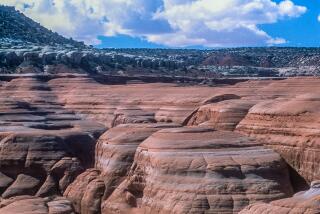Big-City Access Frees Park City of Economic Problems
- Share via
PARK CITY, Utah — In the 1800s, only the most fool-hardy of pioneers attempted to enter the Salt Lake Valley through Parley’s Canyon, the most treacherous pass in the Wasatch Mountains.
Icy, whipping winds, treacherous terrain and the occasional avalanche combined to isolate the mountain area above Parley’s, even when huge quantities of silver were discovered by soldiers sent to keep an eye on the Mormon pioneers during the Civil War.
Now Interstate 80 runs through Parley’s Canyon, with six wide, frequently plowed lanes that allow easy access between Salt Lake City at the bottom and Park City, the burgeoning resort community just 30 miles up Parley’s.
While winter resorts across the West deal with the economic stratification caused by high rents and low wages, convenient geography frees Park City from many of the burdens of success.
“The I-80 is the reason we don’t have a lot of the problems that the Aspens and the Sun Valleys have,” said lifelong Park City resident Gunner Krause. “This is an easy-access resort; we’re really just a suburb of Salt Lake City.”
“I live in Sugarhouse [a middle-class suburb of Salt Lake], and I drive up [to Park City] six times a week,” skiing instructor David Green said. “It’s not that big of a deal; in fact, I prefer it because you can get big-city stuff in Salt Lake and get great skiing 25 minutes away. You get the best of both worlds up here.”
“In terms of logistics, this is the way every ski resort town should be,” said waiter Mack Arroway.
The interstate also eliminates the traffic jams on narrow, winding mountain roads that have become common near exclusive ski resorts. The road was also a prominent factor in the Salt Lake Olympic Committee’s decision to stage more than one-third of the events of the 2002 Winter Olympics in Park City.
For those who do live in Park City and nearby unincorporated areas of Summit County, housing is expensive--but only slightly more so than in Salt Lake.
“It’s really not so bad to live here,” said restaurateur Elaine Cleary. She and her husband and two children lease a five-room condominium for $1,100 a month. “I know in Aspen and places like that, nobody lives in town, but in Park City, if you want to, you can probably find someplace nice that you can afford.”
Nearly 10,000 people make the Park City area their year-round home. This mining town that nearly died before the 1950s skiing boom now has more than 3,400 hotel rooms, over 100 lodging properties and 90 restaurants and clubs.
More to Read
Sign up for The Wild
We’ll help you find the best places to hike, bike and run, as well as the perfect silent spots for meditation and yoga.
You may occasionally receive promotional content from the Los Angeles Times.






